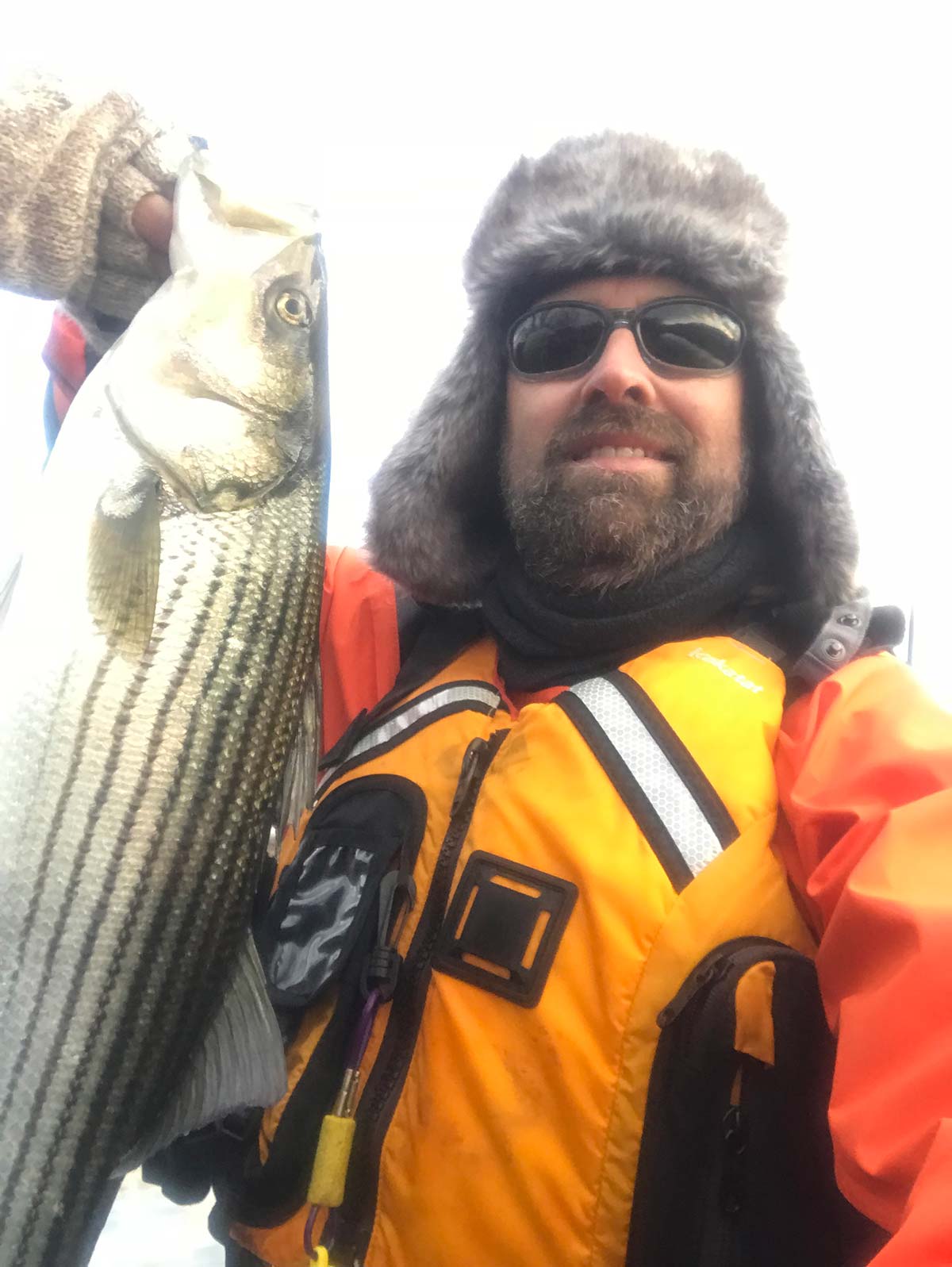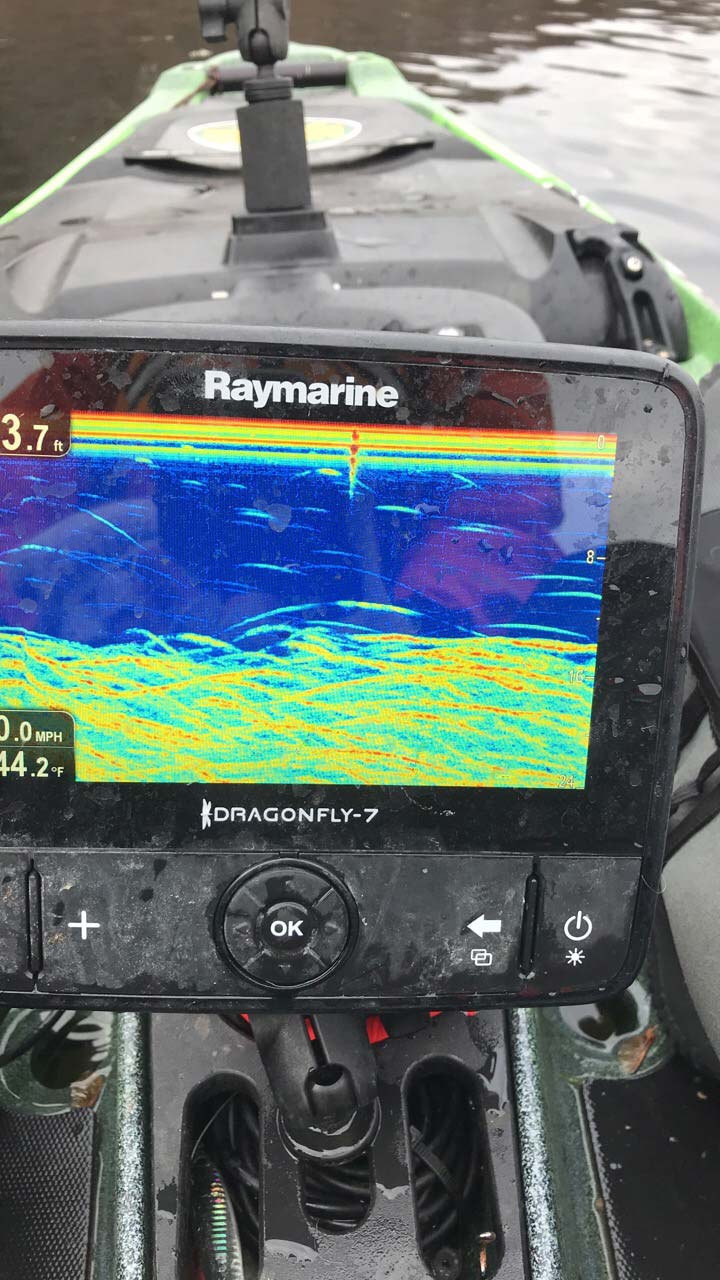
A kayaker’s guide to fishing the herring run on the Housatonic River.
The Housatonic River is famous for its winter striped bass fishing. During this time, the river experiences heavy fishing pressure as anglers travel from all over New England to face the cold with the hope of connecting with a wintertime striper. Generally, these fish are in the 18- to 26-inch range.
The fishing pressure fades in the spring as other fishing opportunities pull anglers into different fisheries. But they are missing out of some of the most exciting fishing the Housy has to offer. When the herring begin ascending the river in search of suitable spawning water, the remaining holdovers take notice and new bodies of migrating fish will join them—setting up some awesome springtime striper fishing. Many of these bass are large. The herring run gives a kayak angler a chance to fish the Housatonic in relative seclusion in comparison to fishing amongst the winter fleet.
These stripers can provide excellent light tackle action during the herring spawn and the kayak provides the flexibility needed to take full advantage.
Fishing The Spawn
Herring reach spawning age when they are 3 to 5 years old and have a life expectancy at least 12 years. They mostly spawn in estuaries. Adults spend most of their lives in saltwater and only return to freshwater to spawn. Spawning runs typically occur between April and June in Connecticut. They typically spawn in faster currents. Adults return to the sea after spawning. Juveniles feed in the rivers until the autumn and then migrate back to the salt. Herring numbers are currently low in Connecticut for reasons that are not fully understood.
Herring normally begin the spawning run on the Housatonic at the beginning of April. As they migrate up the river, their travels come to an abrupt halt at the Derby Dam. The dam blocks upstream access to the herring and causes them to stage below the dam for extended periods of time. Striped bass use this opportunity to corner the herring and ambush them by corralling them against the dam. For this reason, an angler should focus his efforts in the area around Derby Dam where fish will be constantly moving. However, a heavy rainfall will often push the stripers back towards to the Sound to areas of greater salinity.
Not Just Schoolies
Unlike the winter striper run, these striped bass are generally fewer in numbers but much larger with some of the biggest striped bass of the year caught at this time. Many fish in the 40-inch class are caught every year on the Housatonic during the herring run. It is important to fish during moving water and the best bite normally occurs at times of peak tidal movement. At slack tide, the schools break up and the stripers disperse. Moon periods often offer better fishing due to the greater tidal flow.
The Housatonic is a large river with very deep channels and stripers are less inclined to gravitate to structure and will move along the bottom half of the water column in the open water of deep channels and will hound the herring schooling in open water. As such, structure is usually not an important factor for location. A reliable fishfinder can be extremely helpful but is not essential to success. If sonar isn’t an option, a kayaker can follow the “tin can hatch”. The “tin can hatch” refers to the congregation of boats over striper schools. Although you won’t be working with the precision of a fishfinder, you will still catch bass.
Put It On Plastic
Plastics will be the most useful tool in your arsenal for targeting stripers during the herring run. Match the hatch with plastics that are similar in size to an actual herring. Color should also be approximated and blue is often the go-to color while fishing the herring run. Blue-backed shads work very well if the stripers are running shallow. However, if the stripers are suspending over deep water, paddle tails, Hogys, Fin-S Fish, Bass Assassins, and Slug-Go’s on a jighead will all work well.
Sometimes, you will notice stripers pushing bait up to the surface, if you see this, make sure that you’re prepared! Rigging a second a setup with a weightless Slug-Go or paddletail will get you into the action fast, because these mini blitzes are often too quick for re-rigging your primary stick. Use a sturdy size 8/0 hook for fishing weightless. The Mustad Big Bite Soft Plastic Hook is a popular choice for this application. To avoid any slippage, Super Glue the plastic to the top end of the hook. For fishing weightless with long, slender plastics like a Slug-Go, the plastic should be rigged Texas-style on a corkscrew bait keeper and fished weedless. In just about every scenario, the type of plastic lure used isn’t nearly as important as how and where it is presented.
I’ve had my best success fishing horizontally over schools of bass feeding on herring by casting over them and working the jig through the school. With warming water, a faster retrieve works better. After letting the jig fall to the bottom, the jig should be retrieved with hard twitches. More specifically, let the jig sink and make three sharp twitches, each about 6 inches in length and then let the jig fall and countdown, 5 to 10 seconds, as it drops. After reeling in the slack, the retrieve should be paused before imparting any further action because the jig will often be taken on the drop. If you are working a school that you see on your sonar, count down to the depth where that school is holding. Using the countdown method, your jig will sink at a rate of approximately 1 to 2 feet per second, depending on the weight of your jig.
Once your presentation is in the school, use the countdown method again to keep it there by waiting about 5 seconds before beginning your retrieve again. If you find stripers crashing on the surface, cast and retrieve immediately with constant fast twitches until you bring the jig back to the boat. Don’t give up on the retrieve until it is next to the boat, as a striper will often commit at the very last second. Vertical jigging with bigger plastics can also be productive. For this, 10-inch plastics work well jigged off the bottom. The jigging motion with the bigger plastics is much more deliberate.

Tackle And Tech
In terms of necessary tackle for this style of fishing, a fast action medium spinning rod paired with a reel in 4000 to 5000 class spooled with 30-pound braid is my preferred combo. Tie the jig to a 20-inch length of 20-pound mono or fluorocarbon leader. The leader should be connected directly to the braid using the braid to mono knot of your choosing, so that you can reel the leader though the rod tip to make smooth and long casts.
For casting or jigging plastics, a pedal-powered kayak offers a huge advantage. Oftentimes a kayak angler will be faced with tough conditions, including heavy wind and current. While a boat or paddle kayak cannot control their drift, a pedal kayak allows an angler to operate hands free without drifting. Stemming the current by pedaling offers a huge advantage in this fishery. Firstly, it affords the angler greater control of the jig. While pedaling, the kayak will remain still if you point the nose of the kayak into the wind or current. As a result, the jig won’t float up in the water column as the kayak drifts and you can work it off the bottom through the zone where the bass are holding. Secondly, pedaling will allow you to stay over a pod of stripers without drifting away from the school.
Trolling
| DRAGGING FEATHERS |
| At times, stripping a fly through these massive schools of striped bass will outfish all other presentations. The erratic darting motion of a Clouser or Deceiver is often irresistible to stripers. However, this fishing is technical and it takes some practice to achieve success in the deep and wide Housatonic River. Firstly, you must tailor your tackle for this type of fishing. This requires full sinking line (fast sink) matched to a stiff rod. The rod should also be long to increase casting ability. Casting from a sitting position in a kayak can be challenging so kayaks that allow you to stand and cast are a better choice. If you are forced to remain seated, sit side-saddle on your kayak to achieve maximum clearance and leverage. Sinking lines are even difficult to cast standing, so your best bet is to use at least a 10 weight fly rod. Although I’ve often fished with an 8 weight, it’s difficult to control but doable. Trolling flies on full sinking line is also a very good searching method if the schools are dispersed. The tackle for this is the same as casting. |
Trolling with plastic shads or deep diving crankbaits is another effective method, my go-to crank is the Rapala Shad Rap. For this, 4-inch shads and 3-1/2 inch Shad Raps work best. Again, blue-backed baits seem to draw the most attention. Although trolling will produce, it is often difficult to get your presentation into the zone, the bottom third of the water column. The deep diving Shad Raps only swim to about 17 feet max. In addition, getting an accurate sense of swimming depth is difficult while trolling plastic shads.
For trolling plastic shads, the best strategy is to let out as much line as possible. The more line that is released, the deeper the plastic shad will swim. In terms of tackle, you will need to upsize from your casting outfit for trolling. The drag caused by trolling requires heavier fishing tackle. A medium-heavy rod with at least a 4000 class reel is necessary. Troll with 30-pound braid tied to a 30-pound mono or fluorocarbon leader.
Don’t Wait
Fishermen often ignore this pattern with the local spring saltwater fishing peaking around this time. I look to fish this pattern during windy weather that keeps me off the harbors of the Long Island Sound. Oftentimes, you can find protection from the wind in three directions on the Housatonic. I have had some awesome days fishing this pattern in such windy conditions in April and May, but the key to success is committing time to searching for schools on your sonar and not fishing blindly. Even if it isn’t windy, dedicating a few days to the Housatonic during the herring run is a good investment of time and could lead to your biggest striper of the season.




